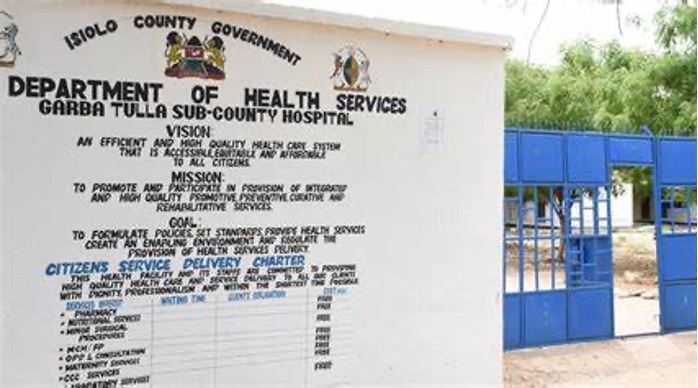In this blog post, we tell the story of Isiolo, a county in the arid eastern region of Kenya, and its efforts to enable government health facilities to participate in the country’s free maternity scheme. The challenges Isiolo has faced – and is now working to overcome – offer important lessons for the country’s universal health coverage (UHC) plans that involve extending government-subsidized health insurance to the poor.
A promising start: Isiolo’s initial experience with Kenya’s free maternity policy
Our story begins in 2013, when Kenya introduced a free maternity policy abolishing user charges for deliveries at all government health facilities. The Ministry of Health (MOH) started giving counties funds to compensate them for the revenue they were losing by not charging fees. This was based on service utilization data from the health information system and not on claims from facilities.
Cut to Isiolo, which ranks amongst the poorest of Kenya’s 47 counties. During these early days when MOH was operating the free maternity program, the county received significant amounts of funds from the National Government. In fiscal year (FY) 2015/16, Isiolo got 18.7 million shillings (~187,000 USD), an amount that accounted for half of the earmarked funds for health that the National Government gave the county that year. The funds went up to 21.2 million shillings (~211,000 USD) the following year.
Isiolo’s woes begin
In 2017, MOH transferred the free maternity program to the National Hospital Insurance Fund (NHIF), Kenya’s government-owned social health insurance agency. Under the new program, which was renamed Linda Mama and expanded to include private providers, any pregnant woman can register with NHIF to access a broad range of maternal and newborn health services free of charge at a contracted provider of her choice. The providers submit claims to NHIF, which then pays them based on predetermined rates.
The problem in Isiolo was that only one facility, namely the county teaching and referral hospital, was contracted by NHIF. The rest could not register women under the Linda Mama program or submit claims to NHIF. As a result, Isiolo received a meager 1.2 million shillings (12,000 USD) for maternity benefits from NHIF in FY 2017/18 – a drop in revenue of over 90%! Its intake increased slightly to 1.6 million shillings (~16,000 USD) the following year[1].
In 2018, organizations like ours working on county-level health financing were starting to engage the County Government of Isiolo to support more government health facilities to participate in NHIF’s Linda Mama scheme. Then the National Government launched a new program to help the country make progress to UHC. And this introduced new complications in Isiolo.
Kenya’s new UHC plan and its implications for Isiolo
In December 2018, the National Government announced a four-county pilot of the Afya Care program to enable Kenyans to access healthcare without facing financial hardship. Isiolo was one of the four counties selected to participate in this first phase of what is commonly referred to as the “UHC scheme” in Kenya. These county governments agreed to discontinue all user charges at public facilities and, in return, received additional resources from the National Government.
In January 2019, NHIF sent a letter to the four pilot counties announcing that it was discontinuing Linda Mama for beneficiaries from those counties.[2] The rationale was straightforward. All services were now free in government facilities and pilot counties were receiving significant additional funds to replace the lost revenue. Hence, there was no need for additional reimbursement under the free maternity scheme. Indeed, Isiolo received an allocation of 725.7 million shillings (~7.2 million USD) during the pilot, which it used to improve health services at all levels of care. Over 90% of the county’s population registered for the program.
Then in December 2020, the National Government announced a new design for the UHC program. Herein lies the final plot twist. Instead of giving counties grants to discontinue user fees at public facilities, the National Government opted to pursue a health insurance approach. It made provisions to subsidize NHIF insurance cover for a million poor households from across the country, which it will eventually expand to cover all poor households in the country.
And thus, Isiolo was confronted once again with the basic problem that most of its government health facilities are not set up to submit claims to NHIF. This is not only important for the facilities to participate in Linda Mama, which has since been restarted in the pilot counties. It is also critical for the UHC program, which will rely entirely on NHIF reimbursing facilities for services delivered to 7609 poor households registered in Isiolo.
Isiolo’s efforts to enable more government facilities to work with NHIF
With support from partners like us, the County Government of Isiolo and NHIF have been working closely over the past 10 months to address this problem. Most health centers in Isiolo do not have the infrastructure to interface with NHIF’s claims submission process. Nor do their staff have any experience submitting claims to NHIF.
Much of the work in recent months has focused on finding workable solutions for claim submissions; for example, the County Government has worked to get facilities mobile phones and desktops so they can notify NHIF about services offered. County officials and NHIF have also trained nearly five dozen staff from both public and faith-based health facilities. Most importantly, county officials, NHIF staff and health facilities managers are meeting regularly to identify challenges in real-time and devise immediate solutions. As a result, 13 facilities had started submitting Linda Mama claims to NHIF as of March 2022 and 11 of them have started receiving payments.[3]
Another critical part of the solution is assuring financial autonomy for government health facilities in Isiolo. The public financial management (PFM) law in Kenya gives county governments the mandate to pass legislation authorizing public sector entities like health facilities to retain and spend the revenue they generate. However, many counties have yet to adopt this approach. Without it, public facilities are unlikely to feel incentivized to submit claims to NHIF, even after the capacity and physical infrastructure constraints are addressed. Isiolo county passed a law granting facilities greater financial autonomy earlier this year and is now working to operationalize a “facility improvement fund” that will ring-fence revenue from health facilities for their use.
The lessons for Kenya and beyond
Key agencies leading the UHC program in Kenya have understandably focused on NHIF registering poor households. An important next step needs to be about ensuring that the facilities where program beneficiaries access services have the motivation and the wherewithal to submit claims to NHIF. Indeed, this is a challenge that many primary care facilities are facing across Kenya, as a recent study on Linda Mama implementation documents.
The moral of this story from Kenya for all countries undertaking health purchasing reforms is somewhat obvious, but worth stating all the same. No purchasing reform can succeed if facilities are not set up to be purchased from. A lot of the effort in purchasing reforms focuses on the purchaser: what services they cover, how they contract providers, and how much they pay for the services. Isiolo’s experience suggests that assessing and assuring the readiness of providers to participate in the purchasing arrangement is just as necessary. Put another way, it takes two to tango.
Notes
[1] Ministry of Health (2020). Public Expenditure Tracking Survey 2017/18 and 2018/19.
[2] Letter from NHIF to the County Government of Isiolo.
[3] NHIF shared these numbers with the authors.
By Nirmala Ravishankar (ThinkWell), Shano Guyo (ThinkWell Kenya) and Janet Keru (ThinkWell Kenya)
Disclaimer: The responsibility for opinions expressed in this blog lies solely with its author(s). This disclaimer applies to any means of dissemination, distribution or publication of said blog at any time.


